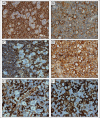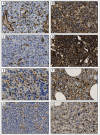HLA dependent immune escape mechanisms in B-cell lymphomas: Implications for immune checkpoint inhibitor therapy?
- PMID: 28507804
- PMCID: PMC5414870
- DOI: 10.1080/2162402X.2017.1295202
HLA dependent immune escape mechanisms in B-cell lymphomas: Implications for immune checkpoint inhibitor therapy?
Abstract
Antigen presentation by tumor cells in the context of Human Leukocyte Antigen (HLA) is generally considered to be a prerequisite for effective immune checkpoint inhibitor therapy. We evaluated cell surface HLA class I, HLA class II and cytoplasmic HLA-DM staining by immunohistochemistry (IHC) in 389 classical Hodgkin lymphomas (cHL), 22 nodular lymphocyte predominant Hodgkin lymphomas (NLPHL), 137 diffuse large B-cell lymphomas (DLBCL), 39 primary central nervous system lymphomas (PCNSL) and 19 testicular lymphomas. We describe a novel mechanism of immune escape in which loss of HLA-DM expression results in aberrant membranous invariant chain peptide (CLIP) expression in HLA class II cell surface positive lymphoma cells, preventing presentation of antigenic peptides. In HLA class II positive cases, HLA-DM expression was lost in 49% of cHL, 0% of NLPHL, 14% of DLBCL, 3% of PCNSL and 0% of testicular lymphomas. Considering HLA class I, HLA class II and HLA-DM together, 88% of cHL, 10% of NLPHL, 62% of DLBCL, 77% of PCNSL and 87% of testicular lymphoma cases had abnormal HLA expression patterns. In conclusion, an HLA expression pattern incompatible with normal antigen presentation is common in cHL, DLBCL, PCNSL and testicular lymphoma. Retention of CLIP in HLA class II caused by loss of HLA-DM is a novel immune escape mechanism, especially prevalent in cHL. Aberrant HLA expression should be taken into account when evaluating efficacy of checkpoint inhibitors in B-cell lymphomas.
Keywords: Diffuse large B-cell lymphoma; Epstein barr virus; Hodgkin lymphoma; human leukocyte antigen; immune checkpoint inhibitor; immune evasion; major histocompatibility complex; primary central nervous system lymphoma; therapy response.
Figures



References
-
- Drake CG, Lipson EJ, Brahmer JR. Breathing new life into immunotherapy: Review of melanoma, lung and kidney cancer. Nat Rev Clin Oncol 2014; 11(1):24-37; PMID:24247168; http://dx.doi.org/10.1038/nrclinonc.2013.208 - DOI - PMC - PubMed
-
- Khalil DN, Smith EL, Brentjens RJ, Wolchok JD. The future of cancer treatment: Immunomodulation, CARs and combination immunotherapy. Nat Rev Clin Oncol 2016; 13(6):273-90; PMID:26977780; http://dx.doi.org/2652568310.1038/nrclinonc.2016.25 - DOI - PMC - PubMed
-
- Batlevi CL, Matsuki E, Brentjens RJ, Younes A. Novel immunotherapies in lymphoid malignancies. Nat Rev Clin Oncol 2016; 13(1):25-40; PMID:26525683; http://dx.doi.org/10.1038/nrclinonc.2015.187 - DOI - PMC - PubMed
-
- Ansell SM, Hurvitz SA, Koenig PA, LaPlant BR, Kabat BF, Fernando D, Habermann TM, Inwards DJ, Verma M, Yamada R et al.. Phase I study of ipilimumab, an anti-CTLA-4 monoclonal antibody, in patients with relapsed and refractory B-cell non-hodgkin lymphoma. Clin Cancer Res 2009; 15(20):6446-6453; PMID:19808874; http://dx.doi.org/10.1158/1078-0432.CCR-09-1339 - DOI - PMC - PubMed
-
- Ansell SM, Lesokhin AM, Borrello I, Halwani A, Scott EC, Gutierrez M, Schuster SJ, Millenson MM, Cattry D, Freeman GJ et al.. PD-1 blockade with nivolumab in relapsed or refractory hodgkin's lymphoma. N Engl J Med 2015; 372(4):311-319; PMID:25482239; http://dx.doi.org/10.1056/NEJMoa1411087 - DOI - PMC - PubMed
Publication types
LinkOut - more resources
Full Text Sources
Other Literature Sources
Molecular Biology Databases
Research Materials
